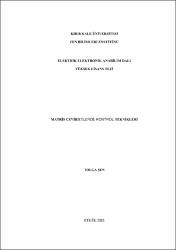| dc.contributor.advisor | Sevinç, Doç. Ata | |
| dc.contributor.author | Şen, Tolga | |
| dc.date.accessioned | 2021-01-16T19:12:22Z | |
| dc.date.available | 2021-01-16T19:12:22Z | |
| dc.date.issued | 2015 | |
| dc.identifier.uri | | |
| dc.identifier.uri | https://hdl.handle.net/20.500.12587/16760 | |
| dc.description | YÖK Tez ID: 418433 | en_US |
| dc.description.abstract | Matris çeviriciler, güç ve frekans çeviriciler arasında elektrolitik kapasitörleri kullanmayışları, artmakta olan güç yoğunlukları, ebatlarının küçük ve hafif olmaları, giriş güç katsayılarının iyileştirilebilmesi ve harmoniklerin azaltılması yönlerinden avantajlıdır. Enerji depolamak için kapasitör kullanmayışları matris çeviricileri tam yarı iletken çözüm olarak endüstriyel kullanıma sunar. Tez kapsamında başlıca matris çevirici yöntemleri incelenmiştir. Yöntemlere ait algoritmalar MATLAB ortamında programlanmıştır. Bu yöntemlerin yüksüz olarak simülasyonları yapılmış, bir anahtarlama periyodu boyunca çıkış gerilimi ortalamalarının, talep geriliminden standart sapmalarına göre ve harmonik içeriklerine göre karşılaştırmaları yapılmıştır. Yüklü çalışmalarda ise rüzgar türbinlerinde çok tercih edilen çift beslemeli asenkron jeneratör uygulaması yapılmıştır. Matris çeviricinin girişi şebekeye, çıkışı çift beslemeli asenkron makinanın rotoruna bağlanmıştır. Makinanın statoru ise yöntem gereği şebekeye doğrudan bağlanmıştır. Matris çeviricinin rotora önce değişken frekanslı sonra sabit frekanslı besleme yapması sağlanmıştır. Bu çalışmada da matris çevirici yöntemleri jeneratör üzerinde verim ve harmonik içeriği yönünden karşılaştırılmıştır. Yönetilen toplam gücün ideal durumda %10-15'i, civarında bir matris çevirici gücünün yeterli olduğu görülmüştür. Kayıplı durumda bu oran %25-30'a çıksa da yine avantajlıdır. Ayrıca matris çeviricilerin diğer çeviricilere göre daha az anahtarlama kaybı içermesinden dolayı rüzgardan elektrik enerjisi üreten sistemlerde kullanılmasının oldukça avantajlı olacağı sonucuna varılmıştır. | en_US |
| dc.description.abstract | Among the power and frequency converters, the matrix converters are advantageous in the aspects of not using the electrolytic capacitors, increasing power densities, being smaller in size and weight, improvability of input power factor and harmonic elimination. Not requiring capacitors for energy storage makes the matrix converter a full semiconductor solution for industrial uses. In this thesis, the main matrix converter techniques have been analyzed. The algorithms of the methods have been programmed in MATLAB environment. These methods have been simulated under no-load conditions and they have been compared according to harmonic contents and the standard deviations between the demand voltage and average values calculated during a switching period. Under loaded operations, they have been applied to the doubly-fed induction generators, which is preferred in wind turbines. The input of the matrix converter is connected to the grid and its output is connected to the rotor of the induction machine. The stator of the machine is connected directly to the grid by virtue of the method. The matrix converter has fed the rotor with variable frequency at the beginning and with a constant frequency later. For this application, the matrix converter techniques have been compared in the aspects of the efficiency and harmonic contents. It is seen that about 10-15% of the governed power is sufficient for the matrix converter power under ideal conditions. It is advantageous even with losses where this ratio reaches about 25-30%. In addition, the matrix converters have less switching losses than the other converters; therefore, it is concluded that their usage in electricity producing systems from wind power is very advantageous. | en_US |
| dc.language.iso | tur | en_US |
| dc.publisher | Kırıkkale Üniversitesi | en_US |
| dc.rights | info:eu-repo/semantics/openAccess | en_US |
| dc.subject | Elektrik ve Elektronik Mühendisliği | en_US |
| dc.subject | Electrical and Electronics Engineering | en_US |
| dc.subject | | en_US |
| dc.subject | | en_US |
| dc.subject | | en_US |
| dc.subject | | en_US |
| dc.subject | | en_US |
| dc.title | Matris çeviricilerde kontrol teknikleri | en_US |
| dc.title.alternative | Control techniques in matrix converters | en_US |
| dc.type | masterThesis | en_US |
| dc.contributor.department | KKÜ, Fen Bilimleri Enstitüsü, Elektrik-Elektronik Mühendisliği Anabilim Dalı | en_US |
| dc.identifier.startpage | 1 | en_US |
| dc.identifier.endpage | 158 | en_US |
| dc.relation.publicationcategory | Tez | en_US |
















